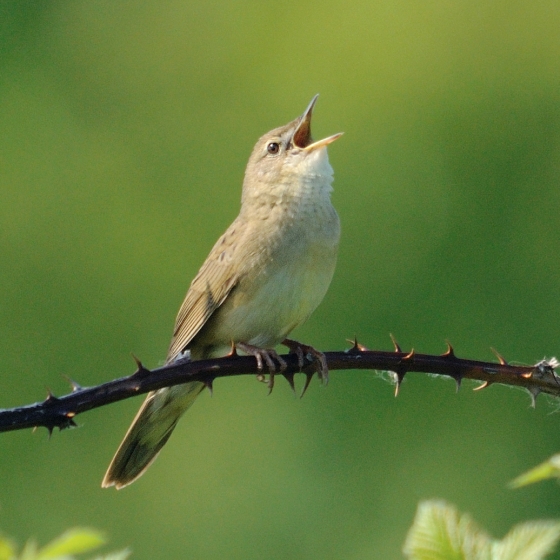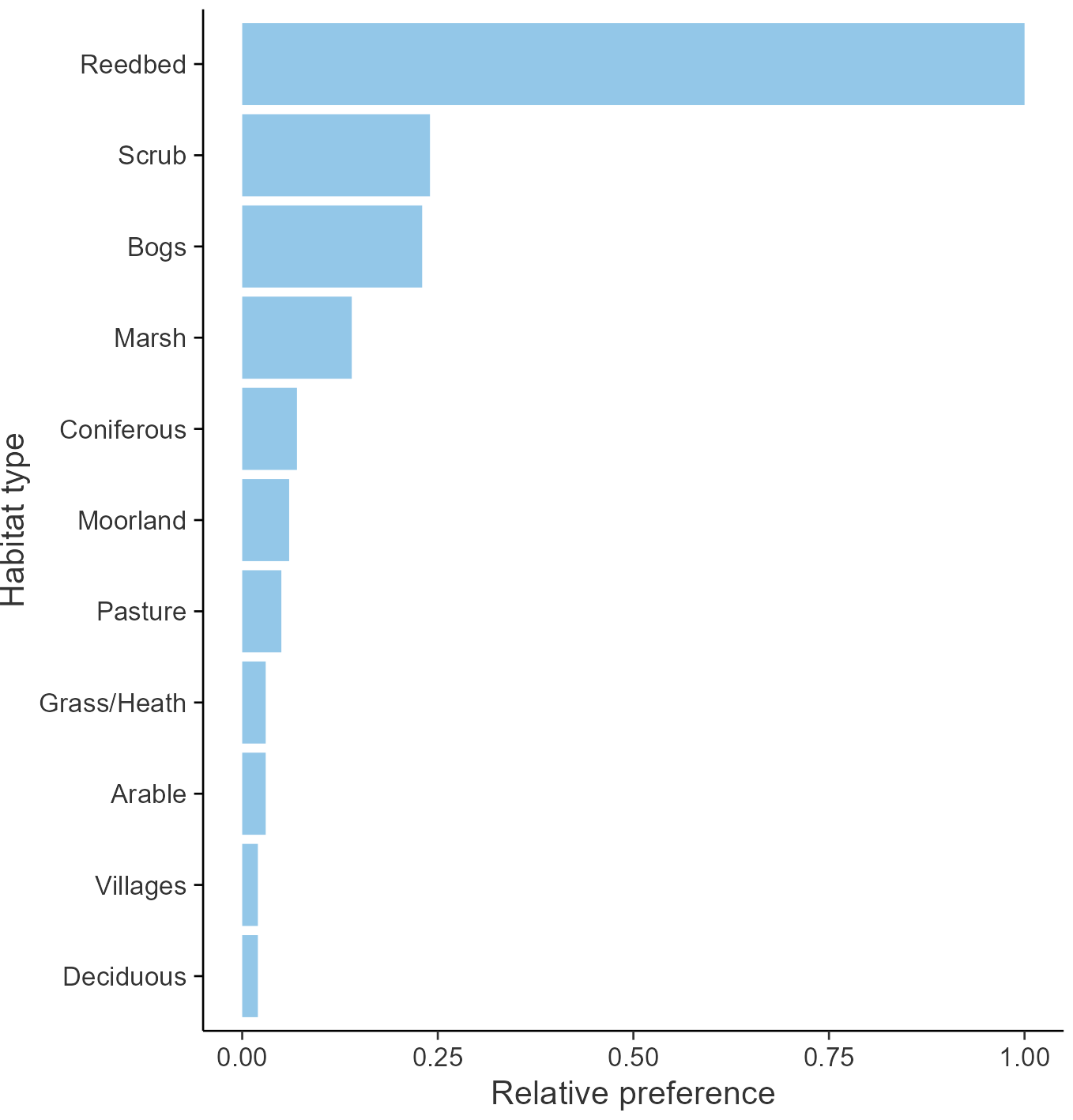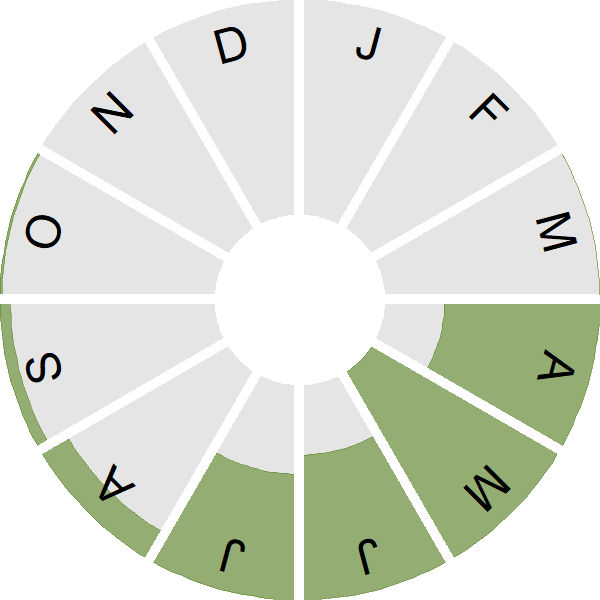Grasshopper Warbler

Introduction
A summer visitor to Britain & Ireland, this otherwise nondescript warbler is most easily identified by its cricket-like song.
In the UK, Grasshopper Warbler numbers declined rapidly from the mid-1960s to the mid-1980s. It also underwent a range contraction, especially in southern and central England. It has been on the UK Red List since 2002. In Ireland, this species is on the Amber List. It is a species of lowland reedbeds, grassland and scrub, where it feeds on insects and other invertebrates.
Grasshopper Warblers start to arrive in Britain & Ireland in April and are gone again by October. They spend the winter months in north-west Africa. They can produce up to two broods per breeding season. Males and females look alike, with brown plumage that is paler on the bird's underside.
- Our Trends Explorer gives you the latest insight into how this species' population is changing.

Key Stats
Identification
Songs and Calls
Song:
Call:
Status and Trends
Conservation Status
Population Change
Grasshopper Warbler was previously amber-listed because of a contraction in range during the period preceding the 1988-91 Atlas (Gibbons et al. 1993). The CBC index suffered from small and severely dwindling sample sizes, but the available data indicate a rapid population decline between the mid 1960s and mid 1980s, when numbers became too small for annual monitoring (Marchant et al. 1990). On this basis, the species is now red-listed. The BBS shows wide fluctuations in abundance since 1995, with no clear trend for the UK and a moderate decline in England. There has been a decline across Europe since 1980 (PECBMS: PECBMS 2020a>).
Distribution
Grasshopper Warblers are widespread throughout much of Britain with the exception of high elevations, the Outer Hebrides and Shetland. There are also gaps in parts of northern England, along the Welsh border, and in southern England. They are widespread in Ireland, except in the southeast. The highest densities are found across Ireland, especially the west, as well as in Wales and southwest Scotland.
Occupied 10-km squares in UK
or view it on Bird Atlas Mapstore.
or view it on Bird Atlas Mapstore.
European Distribution Map
Distribution Change
Breeding Grasshopper Warblers have been lost from a large swathe across English south-coast counties and also pockets in the east and midlands of Ireland. These substantial losses are offset by a marked gains in Scotland, especially in the northwest, and in the extreme west and southwest of Ireland.
Change in occupied 10-km squares in the UK
or view it on Bird Atlas Mapstore.
Seasonality
Grasshopper Warbler is a summer migrant, arriving in April when its reeling song enables easy detection. Birds are detected infrequently during autumn migration.
Weekly pattern of occurrence
The graph shows when the species is present in the UK, with taller bars indicating a higher likelihood of encountering the species in appropriate regions and habitats.

Habitats
Breeding season habitats
Relative frequency by habitat
The graph shows the habitats occupied in the breeding season, with the most utilised habitats shown at the top. Bars of similar size indicate the species is equally likely to be recorded in those habitats.

Movement
Britain & Ireland movement
Foreign locations of birds ringed or recovered in Britain & Ireland
Dots show the foreign destinations of birds ringed in Britain & Ireland, and the origins of birds ringed overseas that were subsequently recaptured, resighted or found dead in Britain & Ireland. Dot colours indicate the time of year that the species was present at the location.
- Winter (Nov-Feb)
- Spring (Mar-Apr)
- Summer (May-Jul)
- Autumn (Aug-Oct)

European movements
EuroBirdPortal uses birdwatcher's records, such as those logged in BirdTrack to map the flows of birds as they arrive and depart Europe. See maps for this species here.
The Eurasian-African Migration Atlas shows movements of individual birds ringed or recovered in Europe. See maps for this species here.
Biology
Productivity and Nesting
Nesting timing
Egg measurements
Clutch Size
Incubation
Fledging
Survival and Longevity
Survival is shown as the proportion of birds surviving from one year to the next and is derived from bird ringing data. It can also be used to estimate how long birds typically live.
View number ringed each year in the Online Ringing Report.
lifespan
Biometrics
Wing length and body weights are from live birds (source).
Wing length
Body weight
Ring Size
Classification, names and codes
Classification and Codes
- Order: Passeriformes
- Family: Locustellidae
- Scientific name: Locustella naevia
- Authority: Boddaert, 1783
- BTO 2-letter code: GH
- BTO 5-letter code: GRAWA
- Euring code number: 12360
Alternate species names
- Catalan: boscaler pintat gros
- Czech: cvrcilka zelená
- Danish: Græshoppesanger
- Dutch: Sprinkhaanzanger
- Estonian: võsa-ritsiklind
- Finnish: pensassirkkalintu
- French: Locustelle tachetée
- Gaelic: Ceileiriche-leumnach
- German: Feldschwirl
- Hungarian: réti tücsökmadár
- Icelandic: Engisöngvari
- Irish: Ceolaire Casarnaí
- Italian: Forapaglie macchiettato
- Latvian: karklu kaukis, cirsis
- Lithuanian: margasis žiogelis
- Norwegian: Gresshoppesanger
- Polish: swierszczak (zwyczajny)
- Portuguese: cigarrinha-malhada
- Slovak: svrciak zelenkavý
- Slovenian: kobilicar
- Spanish: Buscarla pintoja
- Swedish: gräshoppsångare
- Welsh: Troellwr Bach
- English folkname(s): Reeler
Research
Causes of Change and Solutions
Causes of change
The demographic and ecological causes of population change in this species are largely unknown.
Further information on causes of change
There are not enough data to carry out demographic analyses for this species and the causes of the decline, both demographic and ecological, are largely unknown.
Although there is no specific evidence available, as this species is a migrant, it is possible that it has suffered from changes in conditions in the African Sahel zone along with some other trans-Saharan migrants.
Another hypothesis, again lacking good evidence to support or refute it, is that the decline is related to a recent decrease in the amount of suitable scrub habitat preferred by breeding Grasshopper Warblers. There are strong pointers that structural aspects of preferred habitat are important, including heterogeneity, and it seems likely that breeding habitat is limited, at least in some parts of Britain (Gilbert 2012). However, the Grasshopper Warbler's decline has been fairly steep and perhaps too rapid for gradual changes in scrub habitat availability or post-afforestation decline to be major factors (Riddiford 1983).
Information about conservation actions
There is no strong evidence about the reasons for the decline of the Grasshopper Warbler and, as a result, few specific conservation actions have been proposed to benefit this species. A reduction in suitable scrub habitat is one possible cause (2012 and actions and policies to ensure that suitable habitat is available would therefore be prudent until the drivers of decline are confirmed. Four key habitat attributes were identified by Gilbert (

